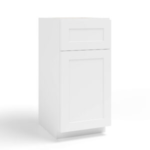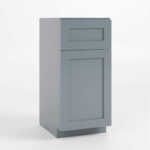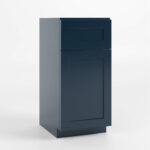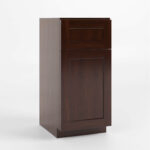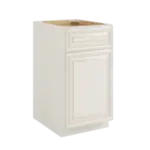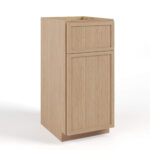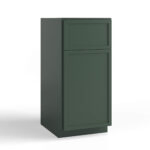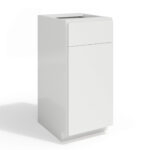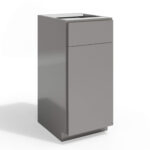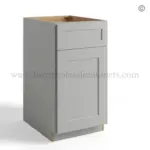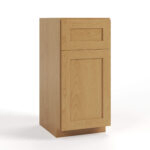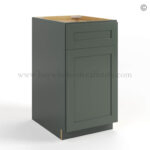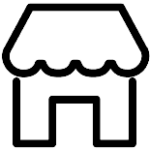Table of Contents
Kitchen cabinets are the heart of every kitchen. They hold your dishes, hide your mess, and make your kitchen beautiful. When there are so many different kinds of kitchen cabinets available to homeowners, it can be tough to decide. Don’t worry—we’ve got you covered.
Knowing your options, whether you are looking for something budget conscious or luxurious custom kitchen cabinetry, will keep the debate short and save on time, money, and frustration. In this kitchen cabinet guide, we will break down everything there is to know about kitchen cabinet materials, styles, and care tips—helping you make the right decision for your home.
Types of Kitchen Cabinets and Popular Styles
Understanding different cabinet types starts with knowing your options. Each style of kitchen cabinet serves different needs, budgets, and design preferences.
Ready-To-Assemble (RTA) Kitchen Cabinets
Ready-to-assemble kitchen cabinets have changed the game for home renovations. These kitchen cabinets arrive flat-packed with everything you need for installation. The best part? You’ll save 40-60% compared to pre-built options while getting the same quality.
Most RTA kitchen cabinets use plywood construction with solid wood doors. The cabinet frame comes pre-drilled, making assembly straightforward with basic tools. Many kitchen cabinet materials in RTA format include medium-density fiberboard cores wrapped in natural wood veneers.
These cabinet materials offer excellent value because manufacturers save on shipping and storage costs. Quality RTA kitchen cabinets include soft-close hinges and drawer slides, giving you premium features at budget prices.
Shaker Style Kitchen Cabinets
American kitchens favor Shaker style cabinets for a reason. The timeless, minimalist style is perfect in any home, from modern to farmhouse. Shaker style offers a recessed center panel surrounded by a flat cabinet frame that is both classic and functional.
In hardwood cabinets such as oak and maple, these kitchen cabinets display natural wood beautifully. Fresh modern looks are created with painted shaker style options in white, gray, or navy blue. This versatility of the design will ensure that your shaker style kitchen cabinets will not go out of style in 5 years.
Shaker style cabinet doors offer more visual interest than flat panels and do a better job of hiding fingerprints. By adding shadows and depth to your kitchen design, the recessed panel helps to create a unique character. Shaker style cabinet frames made with traditional joinery by professional cabinet makers are indestructible.
Flat Panel Kitchen Cabinets
Flat panel kitchen cabinets feature completely smooth cabinet doors without raised or recessed areas. This style creates a modern appearance that works perfectly in contemporary kitchens. The smooth surface makes these kitchen cabinets easy to clean and maintain.
These cabinet doors highlight beautiful wood grains in natural wood species like walnut or cherry. When painted, flat-panel kitchen cabinets offer unlimited color possibilities. The smooth surface also works well with high-gloss finishes that reflect light throughout your kitchen.
Installation of flat panel kitchen cabinets proves easier than traditional styles since cabinet doors don’t require precise alignment of decorative elements. However, the smooth surface shows fingerprints and scratches more easily than textured alternatives.
Raised Panel Kitchen Cabinets
If your kitchen wants sophistication, raised panel kitchen cabinets will give an elegant look as well as a traditional touch to your kitchen. That center panel sticks out from the cabinet frame around it, and adds depth and intrigue. A great choice for traditional American houses and colonial or Victorian homes.
Such cabinets demand a more complicated manufacturing process than flat doors, costing more. But it is a worthwhile investment for timelessness and perceived value. For instance, some quality raised-panel kitchen cabinets will use solid wood with grain patterns that have been matched together.
Compared to flat alternatives, three-dimensional cabinet doors do a better job of camouflaging minor wear and scratches. In addition, the raised panel design offers more exposed area for the ground to display those gorgeous patterns of natural wood grain.
Inset Kitchen Cabinets
Inset cabinets represent premium craftsmanship in kitchen cabinetry. These kitchen cabinets feature cabinet doors and drawers that sit flush within the cabinet frame opening. This creates clean lines and a furniture-like appearance that screams quality.
Installing inset cabinets requires precise measurements and expert craftsmanship. Each cabinet door must fit perfectly within its opening with consistent gaps all around. This precision manufacturing increases costs but delivers unmatched quality.
Inset cabinets work beautifully in traditional, transitional, and high-end contemporary designs. Their furniture-quality appearance adds substantial value to homes, making them a worthwhile investment for many homeowners.
Glass-Front Kitchen Cabinets
Glass-front cabinets add visual lightness to kitchen designs while providing display opportunities. Upper glass-front cabinets break up solid expanses of cabinet doors while showcasing beautiful dishes or collectibles. Various glass options include clear, frosted, or decorative patterns.
These kitchen cabinets work particularly well in smaller kitchens where solid upper cabinets might feel overwhelming. The transparency creates an open feel while maintaining storage capacity. Glass-front cabinets require organized, attractive storage, as the contents remain visible.
Interior lighting in glass-front cabinets highlights displayed items and adds ambient kitchen lighting. This feature turns your kitchen cabinets into attractive display cases that enhance your overall design.
Custom Kitchen Cabinets
Custom kitchen cabinets offer unlimited design possibilities tailored to your specific space and preferences. Every aspect can be customized, from wood species and finishes to hardware and interior accessories. This flexibility solves unique storage challenges.
Custom cabinetry typically uses premium kitchen cabinet materials like hardwood cabinets with traditional joinery techniques. The manufacturing process takes longer but delivers perfectly fitted solutions for any kitchen layout.
The investment in custom kitchen cabinets pays off through superior quality, perfect fit, and personalized design. However, costs run much higher than stock alternatives, and lead times often extend 8-12 weeks.
High Gloss Frameless Kitchen Cabinets
When you want high gloss and little or no frame, our Euro-style cabinets allow the glam. The frameless design opens to provide more storage in view, and the glossy finish is perfect for adding a touch of light reflection to your kitchen. These cabinets are usually made with an engineered wood core.
The contemporary look will match your current European modern and/or European style kitchen. High gloss surfaces are available in many colors, from traditional white to vibrant reds and blues. OMG! The reflectiveness does a great job of visually enlarging and brightening even very small kitchens.
The only thing to keep in mind is maintenance, as a smooth surface makes it easy for fingerprints and water stains. High gloss kitchen cabinets are really just high-quality lacquer. Keeping them clean is as simple as using soap and water.
| Cabinet Type | Style | Cost | Maintenance | Best For |
| Ready-to-Assemble (RTA) | Modern/Traditional | Low | Easy | Budget-friendly renovations |
| Shaker | Classic/Minimalist | Medium | Moderate | Versatile, timeless kitchens |
| Flat Panel | Contemporary | Medium | Easy | Sleek, modern designs |
| Raised Panel | Traditional | High | Moderate | Elegant, classic homes |
| Inset | Premium/Furniture-Like | High | High | Luxury kitchens |
| Glass-Front | Display/Light | Medium | Moderate | Showcasing dishes, small kitchens |
| Custom | Any | Very High | Custom | Unique layouts & personalized design |
| High Gloss Frameless | Modern/Euro-Style | High | Moderate | Contemporary, small, or bright kitchens |
How to Maintain and Care for Your Kitchen Cabinets
Proper maintenance keeps your kitchen cabinets looking beautiful for decades. Different kitchen cabinet materials require specific care approaches to maintain their natural beauty and modern appearance.
Cleaning and Preventing Stains
Regular cleaning helps protect the investment you’ve made in kitchen cabinets. Gentle cleaners are required to clean natural wood finishes so that they don’t damage the finish, but laminate cabinets are harder wearing and can take stronger cleaning solutions.
To perform routine cleaning for kitchen cabinets, start with a mildly soapy solution. Harsh chemicals or too much moisture may harm the cabinet materials, so avoid them. Especially on lighter-colored cabinet doors, stains can form quickly.
For natural wood kitchen cabinets, use a cleaner especially formulated for wood finishes. Melamine cabinets and thermofoil cabinets can be cleaned with standard household cleaners. The smooth surface of these materials wipes down easily without any special products.
Repairing Scratches and Wear
Minor scratches are inevitable with the daily use of kitchen cabinets. Fortunately, most cabinet materials allow for easy repairs. Solid wood kitchen cabinets can be sanded lightly and refinished to remove scratches.
For painted kitchen cabinets, keep touch-up paint handy for quick repairs. Small chips in cabinet doors can be filled with wood filler, sanded smooth, and painted to match. Laminate cabinets present more challenges since the surface layer cannot be easily repaired.
Professional repair services handle extensive damage like deep scratches or water damage to kitchen cabinets. Early intervention prevents minor issues from becoming major problems requiring complete replacement.
Refinish or Replace Your Cabinets
Eventually, even well-maintained kitchen cabinets may need refinishing or replacement. Signs include worn finishes, outdated styles, or structural problems with cabinet doors or the cabinet frame.
Solid wood kitchen cabinets can be refinished beautifully by sanding, staining, and applying fresh protective coatings. This process transforms dated kitchen cabinets into contemporary showpieces. However, kitchen cabinets with structural issues may need complete replacement.
Consider cabinet refacing as a middle option. This process replaces cabinet doors and drawer fronts while keeping existing cabinet boxes. Refacing costs more than refinishing but less than complete replacement.
How to Choose the Right Kitchen Cabinet Style
Several aspects should be taken into consideration when choosing kitchen cabinets, such as the the size of your kitchen, preferences and motifs, budget, and lifestyle. Think about different cabinet materials in your particular situation.
Raised center panels add a craftsman’s quality to traditional kitchens. Modern style rooms go great with flat panel doors, which highlight straight edges. The cabinet frame pattern you decide on will define the decor of your kitchen.
You must take budget into consideration when choosing kitchen cabinets. Knowing the various kitchen cabinet materials enables you to choose what’s best for you. Here are some of the most popular types of cabinet materials.
- Solid Wood: Hardwood cabinets are the strongest and have a rich, natural beauty. Common species are oak, maple and cherry. Solid wood cabinets can be refinished several times, they are an investment that will last you a lifetime.
- Plywood Cabinets: These are built with plywood construction and have real wood veneers. Plywood cupboards provide great stability and are available at a fraction of the cost of solid wood with an attractive, warm finish.
- Medium Density Fiberboard: MDF cabinets are made using wood fibers and a resin binder, creating the cabinet material to be smooth and stable. Medium-density fiberboard paints beautifully and is also cheaper than real wood.
- Particle Board: Composed of wood chips and resin binder, particle board is an inexpensive option for cabinet materials. But particleboard does not survive moisture as well as other engineered wood products.
- Laminate Cabinets: These have particleboard or medium-density fiberboard cores with laminated surfaces. They are durable and come in a wide range of cabinets. Laminate cabinets are an economical choice that delivers value and is easy to maintain.
- Thermofoil Cabinets: These use medium-density fiberboard cores wrapped in vinyl film. Thermofoil cabinets provide smooth surface finishes that resist moisture and staining.
- Melamine Cabinets: Similar to laminate cabinets, melamine cabinets feature engineered wood cores with melamine surfaces. These cabinet materials offer durability and easy cleaning.
If kitchen cabinets are sealed, the vast majority of cabinet material does well in moist environments. The secret is finding cabinetry materials that work with your budget, preferred style, and maintenance requirements.
Conclusion
Knowing how to find your way among the various kitchen cabinet types is what will aid you in making better choices for your remodel. There are three primary styles to consider: stock, semi-custom, and custom cabinetry—each has its particular benefits depending on timing and budget.
Keep in mind your kitchen cabinets are a large portion of your investment in the value of your home and what you’ll spend every day. The materials and construction of the cabinetry are then more important than mere trendiness. Whether you like timeless or contemporary designs, you should make it your point to get kitchen cabinets that suit both your lifestyle and pockets.
The best kitchen cabinets will provide you with years of enjoyment, durability, and use. Spend some time learning about the materials used and decide on what to go for. Buy Wholesale Cabinets is here to present you with quality kitchen cabinets. If you have any concerns or need further information, please do not hesitate to contact us.
Kitchen Cabinets FAQs
What are the most durable kitchen cabinet materials?
Hardwood cabinets are the most durable of all types of cabinets, and some of the common choices include cherry, maple, and oak. Cabinets are often constructed of plywood with hardwood veneer that has good wear and tear potential at an affordable rate. Medium-density fiberboard and particleboard are budget options that may not wear as well.
Which kitchen cabinet style is the most popular?
Shaker style cabinets are still among the most popular types of kitchen cabinets. Their clean lines allow them to blend with a variety of decorating styles, including those that are more traditional and contemporary. There are shaker style white and grey options, everything when it comes to today’s most popular kitchen trends.
How do I choose the best cabinet finish for my kitchen?
When choosing finishes on kitchen cabinets, think about your lifestyle. Natural wood finishes display the grain perfectly but need frequent attention. Painted finishes mask imperfections and are available in any color. High-gloss finishes offer high-impact glamour, but they reveal fingerprints.
Are custom cabinets worth the investment?
Custom kitchen cabinets are worth the investment when you have irregular spaces, appliances, or special storage needs. For common kitchens, prefabricated kitchen cabinets of good quality will carry out the job better in terms of beauty.
How can I maximize storage in my kitchen cabinets?
Interior accessories such as pull-out shelves or drawer dividers add increased storage to kitchen cabinets. Durable full-extension drawer slides make it easy to reach the back of drawers. Tall kitchen cabinets that go all the way to the ceiling allow for more storage.
